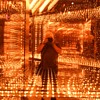Posted 12 years ago
 rniederman
rniederman
(346 items)
I thought it might be fun to show a couple beautiful stereo cameras that used roll film. Here is a No.2 Stereo Brownie made by Kodak; about 4,000 were made during its run from 1905 to 1910.
Growing up in the 1950s and 1960s, just about every family was familiar with the inexpensive and popular line of Brownie box cameras sold by Kodak (such as the classic Brownie Hawkeye in molded Bakelite). Yet this stereo brownie is an early Brownie not often seen and quite scarce.
Unlike the simple box designs, this is a distinctive, leatherette covered folding camera with twin red leather bellows, wide polished wood face, and funky looking brass shutter with maker's I.D. The original list price was $12 in 1905.



























Thanks, Sean!
Thanks, AR8Jason!
Thanks pawis, officialfuel, miKKo, and Hardbrake!
Thanks toolate2 and walksoftly!
So the idea is to expose the same film to 2 diff. perspectives to give a 3D effect? I'm not a camera collector obviously.
Thanks, mtg75!
Hi blunderbuss2 ... you got it right.
In summary, the 3D effect needs two lenses separated by about the same distance as an average pair of eyes. (This is referred to as interocular distance.) Although a couple inches doesn't seem like much, each image is slightly different; yet the difference is just enough for your mind to recreate 3D depth perception when looking in a viewer (or similar).
Look carefully at my 'man on the girder' stereoview (or any stereoview) and you'll see that the images - although nearly identical - have slightly different perspectives.
http://www.collectorsweekly.com/stories/69791-photographers-and-their-cameras--iconic-1
As a note, some view cameras have lens boards that allow photographers to adjust the interocular distance between lenses. The larger the distance between lenses, the greater the 3D effect.
Thanks, Phil!
Thanks, Eric!
Thanks shughs and mustangtony!
Thanks, chrissylovescats!
Thanks, sanhardin!
Good explanation of the "3D effect".
I have seen some 1860s stereos where the photographer thought the trick was in the viewing. The photographer glued two of the same image onto a mount! The stereoview appears flat, like a normal single photo when viewed.
There are varying degrees of quality and depth to the views. Some of the best that I have seen are French Diableries tissue views-- amazing depth and quality to the scenes. Of course the tinting aids in bringing the scene to life.
scott
Thanks, Scott (and for the great comments)!
Thanks, Chevelleman69!
Thanks, miike!
Thanks, AmphoraPottery!
Thanks, bratjdd!
Thanks, aghcollect and Sean!
Thanks, farmlady!
Thanks, aghcollect!
Nice camera!
scott
Thanks, Scott. On the "mystery" post, I added a picture of the device with the Stereo Brownie.